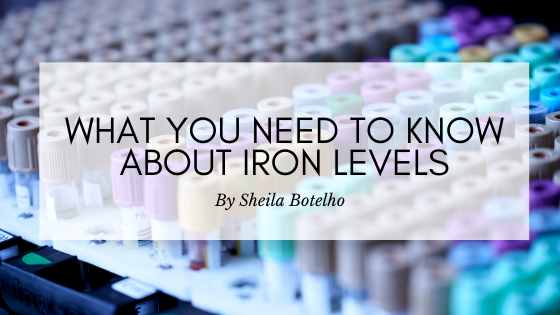For many years now, I have gotten an annual blood test. I typically compare my blood tests year over year to take note of any changes that may show up.
As you can imagine, 2020 meant a long delay in getting tested, as clinics had limited access. The last appointment with my doctor I had to go over my blood test results was way back at the end of 2019 and everything was looking great.
I felt great too and my doctor had positive things to say about my overall health markers.
I love to check in with my doctor each year to have a good conversation around new findings and things that I’m researching and to get his perspective. He’s gotten used to me coming in with lists of questions and he always indulges me, taking his time answering my questions. I’m grateful to have a caring doctor.
My schedule at the end of 2019 got fuller than expected, so I didn’t get around to booking my annual checkup and blood test until January. By that time, my clinic was booking into March. Right when the world shut down.
With limited clinic space and stay at home orders, I was finally able to secure a phone appointment with my doctor. And as you’ll go on to read, it came at the perfect time.
As I’ve been sharing over the last few years about the connection with women’s cyclical rhythms and health, I’ve been journeying through the late stage of perimenopause. I have noticed some cycle shifts and what I believed to be minor symptoms, which is to be expected.
Also, 2020 had all of us face many different emotions and stressors, which I believed had affected my energy levels to a degree. I didn’t feel strange about the fact that I was feeling tired at times. And I did notice that I was experiencing hair loss and brittle nails, heavier periods, and menstrual headaches, which is often associated with the menopausal journey. Otherwise, my energy was pretty good most of the time and I didn’t really question anything.
My blood had a different story to tell.
During my follow up phone appointment with my doctor, we went over my blood test results. He told me that everything looked really good… except for my ferritin levels.
What’s Ferritin?
Ferritin is a protein that stores iron and releases it when it’s needed. In most cases, it remains in your body’s cells with very little actually circulating in your blood.
The highest concentration of ferritin is found in your liver and immune system and is stored in these cells until more red blood cells are needed to be generated. This leads to a chain of cellular events that keeps your body operating healthfully.
You may know that it’s important to have normal iron levels, but if you don’t have enough ferritin, your iron stores can deplete quickly.
So many questions were answered.
It turns out that the heavy perimenopausal menstrual cycles I’d been having for the last 18 months severely depleted my ferritin levels. My hair loss and nail breakage indicated this depletion over time, but it wasn’t until the week I got my test results back that my energy took a dive and I began to feel shortness of breath under normal exertion. And several weeks before, I experienced my first menstrual migraine, nausea and all.
I was grateful to have some answers and to know that my situation could be easily remedied. My doctor started me on a specific dose of iron, which I’ll be using for the next three months to get my ferritin levels back to where they should be. Then I’ll do another blood test.
I’ll also continue eating foods that are abundant in iron such as:
Dark-green leafy vegetables, such as spinach, seaweed, broccoli, parsley, asparagus, watercress, and kale and seafood, chicken, lentils, beans, fortified grains, nuts, seeds, dried fruits, tofu, molasses, soy, eggs, and lean red meat. I’ve also witnessed in others and experienced for myself the benefits of adding maca and spirulina to your meals. They’re not only an ideal iron boost, but are great for your overall health and energy levels.
What was so interesting to me was that my B12 and hemoglobin levels were off the charts, due to the many plants and high vibe supplements I take. Yet even so, I had simply depleted my storage levels. My multivitamin doesn’t include iron, because under normal circumstances, it’s abundant in our bodies. Too much iron can be toxic. The prenatal version of my multivitamin does include Iron (Ferrous Fumerate, 14 mg), but I’m in a different stage of life now. 🙂
It’s so easy to take for granted, but our lifeblood is just that. The life flowing within us. And it has so much to tell us, if we make time to listen.
I wanted to share my story with you because I could have chalked my symptoms up to “Just what happens as we age.” But instead, I got curious, learned the root cause of my symptoms, and took action to make changes.
It’s why I’m so passionate about having annual doctor checkups and blood tests. Small changes over time add up and can lead to big challenges later on if we’re not paying attention. The same is also true for the good habits you keep. They add up over time for a much more enjoyable life.
Iron Basics
Your blood test looks at levels in many different areas. Here’s what the ones related to your iron levels mean.
Hemoglobin
The protein molecule in red blood cells that carries oxygen from the lungs to the body’s tissues and returns carbon dioxide from the tissues back to the lungs.
Hematocrit
The proportion, by volume, of the blood that consists of red blood cells.
Ferritin
A protein that stores iron and releases it when it’s needed. In most cases, it remains in your body’s cells with very little actually circulating in your blood.
B12
A vitamin required to make red blood cells, which carry oxygen to all parts of your body.
MCH
The average quantity of hemoglobin present in a single red blood cell.
MCHC
The average concentration of hemoglobin in your red blood cells.
Vitamin D plays a role
Research suggests that vitamin D and iron are cofactors for each other. If you don’t have enough vitamin D, you can’t absorb iron properly and if you don’t have enough iron, you can’t have adequate vitamin D levels. Vitamin D indirectly regulates iron metabolism to reduce the body’s inflammatory response. Inflammation can also dramatically reduce iron absorption.
Possible causes of iron deficiency in women:
- Insufficient iron intake
- Family history
- Ethnicity
- Age
- Frequently drinking tea or coffee
- Pure vegetarian diet
- Organ injuries, diseases or infections
- Pregnancy
- Infections or ulcers
- Heavy menstrual bleeding
Symptoms of iron deficiency in women:
- Changes in menstrual bleeding
- Extreme fatigue
- Digestive problems
- Skin paleness
- Low body temperature
- Nail problems & hair loss
- Bruises
- Headaches
- Nausea
- Shortness of breath
If you’ve been putting off booking your annual check up and blood test, I highly encourage you to do it now. I always recommend that you talk to your doctor, as everyone’s body, ancestry, and stage of life is different. Low level symptoms that you may be experiencing that are easy to miss could be related to thyroid issues, vitamin D or B12 deficiency, adrenal fatigue, elevated blood glucose or cholesterol levels, or iron deficiency in some form.
Tell Me:
Do you have specific routines around your wellness markers throughout each year? What surprised you from what you read here? Please share in the comments. You and other readers can cheer each other on towards elevating your self care. When you do, we all win!
I hope my story will encourage you to be proactive about your health. You know your body best. Make sure your numbers are where you want them to be. Alongside your doctor’s guidance, stay tuned to this blog for resources on beautiful things to eat and supplement with to help you fill in nutritional gaps so you can experience your most vibrant health.
Want more healthy lifestyle tips and tasty nutritious recipes? Subscribe here to get them fresh off the press straight to your inbox.
Blessings,
Sheila

